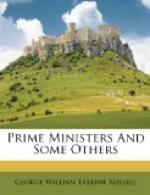The hideously named “Pan-Anglican Synod,” which assembled at Lambeth in September, 1867, and terminated its proceedings in the following December, was a real movement in the direction of Life and Liberty for the Church of England. The impulse came from the Colonies, which, themselves enjoying the privilege of spiritual independence, were generously anxious to coalesce at a time of trial with the fettered Church at home. The immediate occasion of the movement was the eccentricity of Bishop Colenso—“the arithmetical Bishop who could not forgive Moses for having written a Book of Numbers.” The faith of some was seriously perturbed when they heard of a Bishop who, as Matthew Arnold said, “had learnt among the Zulus that only a certain number of people can stand in a doorway at once, and that no man can eat eighty-eight pigeons a day; and who tells us, as a consequence, that the Pentateuch is all fiction, which, however, the author may very likely have composed without meaning to do wrong, and as a work of poetry, like Homer’s.”
Certainly the tremors of a faith so lightly overset were justly obnoxious to Arnold’s ridicule; but Colenso’s negations went deeper than the doorway and the pigeons; and the faithful of his diocese, being untrammelled by the State, politely dismissed him from his charge. In England steady-going Christians had been not less perturbed by that queer collection of rather musty discourses which was called Essays and Reviews; and the Church of England had made an attempt to rid itself, by synodical action, of all complicity in the dubious doctrine. But the Judicial Committee of the Privy Council had justified the essayists, and had done its best to uphold Colenso. By so doing, it had, of course, delighted all Erastians; but Churchmen, whether at home or abroad, who believed in the English Church as a spiritual society, with a life of its own apart from all legal establishment, felt that the time had come when this belief should be publicly proclaimed. In February, 1866, the Anglican Bishops of Canada addressed a Memorial to Dr. Longley, then Archbishop of Canterbury, requesting him to summon a conference of all the Bishops of the Anglican Communion; and, after some characteristic hesitation, this was done. A Letter of Invitation was issued in February, 1867. The more dogged Erastians held aloof; but those who conceived of the Church as a spiritual society obeyed the summons; the “Conference of Bishops” assembled, and the priceless word “Pan-Anglicanism” was added to the resources of the language.
What did these good men do when they were come together? Not, it must be admitted, very much. They prayed and they preached, and debated and divided, and, in the matter of Colenso, quarrelled. They issued a Pastoral Letter which, as Bishop Tait said, was “the expression of essential agreement and a repudiation of Infidelity and Romanism.” If this had been the sole result of the Conference, it would have




